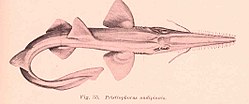This article needs additional citations for verification .(May 2021) |
| Shortnose sawshark | |
|---|---|
 | |
 | |
| Scientific classification | |
| Kingdom: | Animalia |
| Phylum: | Chordata |
| Class: | Chondrichthyes |
| Subclass: | Elasmobranchii |
| Division: | Selachii |
| Order: | Pristiophoriformes |
| Family: | Pristiophoridae |
| Genus: | Pristiophorus |
| Species: | P. nudipinnis |
| Binomial name | |
| Pristiophorus nudipinnis Günther, 1870 | |
 | |
| Range of shortnose sawshark (in blue) | |
The shortnose sawshark, (Pristiophorus nudipinnis) or southern sawshark, is a sawshark of the family Pristiophoridae. The body of this shark is slightly compressed, and its rostrum is narrow. The two dorsal fins are almost identical in size. In color, the dorsal side of this sawshark tends to be uniformly slate gray, with few or no markings. The ventral side is pale white or cream. Females reach around 124 cm (49 in) long, and males reach around 110 cm (43 in) long. These sharks can live up to 9 years.
